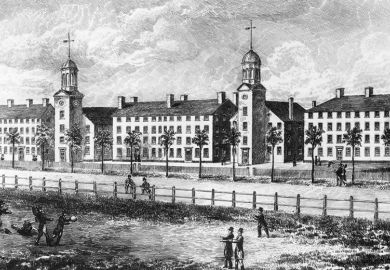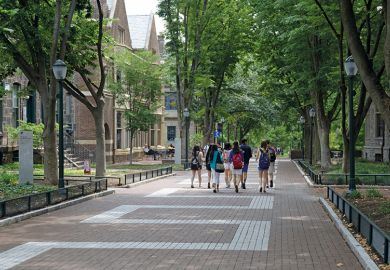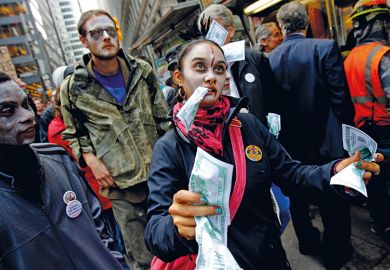The last 75 years of US higher education policy can probably be summarised in three phrases: militarily influenced, historically male and increasingly marketised. For those seeking a detailed explanation of these observations, Roger Geiger’s American Higher Education since World War II provides a comprehensive historical account.
The book is well written, copiously footnoted and makes for an accessible read. It is peppered with factual information relating to four distinct eras from 1945 to the present day.
The early military influence on those institutions associated with commercial research and development prowess today cannot be overstated. This laid the ground for future university-industrial cooperation in biotechnology, information technology and medical research and development, areas in which US corporations have achieved unrivalled global leadership. From nuclear weapons research during the war to the launch of Sputnik in 1957, Geiger illustrates how myriad federal programmes and institutions were spawned to ensure America did not lose the Cold War or the space race. Investment in academic R&D increased as a proportion of GDP from 0.1 per cent in 1957 to 0.25 in 1968.
Post-war enrolments of returning military personnel were also crucial for the financial well-being of many institutions. From 1946 to 1949, more than 1 million US veterans benefited from the provisions of the 1944 Serviceman’s Readjustment Bill or “GI Bill”. As a consequence, hundreds of thousands of engineers, medical professionals and teachers graduated, demonstrating the enormous potential of the US university system when actively harnessed by the nation.
During the height of Cold War paranoia, universities and their faculty did not acquit themselves quite so well. The Association of American Universities asserted that membership of the communist party should “extinguish the right to a university position” and that taking the Fifth Amendment to avoid self-incrimination in the face of vindictive testimony (a constitutional right) would also call into question a professor’s fitness for employment. In secret ballots, the overwhelming majority of faculty supported the exclusion of communists from teaching.
In later years, however, anti-military sentiment emerged, linked primarily to revulsion at the Vietnam War. This led to protests on campuses across America. Recorded disruptions ran into the thousands (731 involving arrests and 231 involving injury). Corporate recruiters with military links (for example, Dow Chemicals, the manufacturer of napalm), were regularly harassed.
Geiger relates how riots, vandalism, occupations and shootings occurred in protests at Columbia College, Cornell University, Stanford University, Harvard University, University of California, Berkeley, Kent State University and elsewhere, illustrating the depth of student disenchantment with the military-industrial complex. This resulted in the symbolic divestment of defence research at institutions such as Stanford and the Massachusetts Institute of Technology, although the activities continued as normal under new governance and ownership arrangements.
Those interested in the part played by women in the academy during the post-war years may be somewhat irritated, if unsurprised, to learn that they enter the story substantively only two-thirds of the way through the book. In a chapter titled “Surviving the Seventies”, Geiger includes sections on affirmative action and the rise of women, noting that “Previously, the idea that women deserved equal treatment with men appeared unnatural and unrealistic.”
In support of this observation, he describes how women students in the immediate post-war period were deemed to be entering a marriage market rather than preparing for a career. Harvard, Yale University and Princeton University did not even admit female undergraduate students until 1969. Happily, the impact of the emancipatory forces of the late 1960s finally began to address the question of equal rights for women thanks to political, legislative and administrative coordination. Stimulated by effective organisation by feminist scholars, women’s studies programmes also took off. By 1976, as Geiger notes, “270 programs had been organized, and 15,000 courses were being offered at 1,500 institutions”.
If the military and male influences on the US academy after the war may sound troubling for many present-day readers, such concerns are more than matched by later worries about the influence of marketisation. For a non-American audience fearful of the inexorable drift of HE policy towards the US model, this book will inspire little confidence. The (mis)use of public funds and student loans in the de facto privatisation of HE, the unfettering of tuition rates and the dramatic increase of student debt make up a very familiar tale in English-speaking jurisdictions. This book describes what things look like when the genie of academic consumerism is fully liberated from the constraints of its socially responsible bottle.
After 1980, according to Geiger, “American Higher Education became increasingly bifurcated between selective institutions – with their higher prices, expenditures, student qualifications, and graduation rates – and open institutions of mass education – with their lower levels of resources, SAT scores, and graduation rates”. As a result, social stratification, as determined by family wealth, has not diminished while student debt grew from $250 billion in 2003 to $1.5 trillion in 2016. The $106 billion in student loans issued in 2016-17 represented three-quarters of university tuition revenues.
Nevertheless, this is an optimistic text based on Geiger’s clear appreciation of the past contributions of American universities and colleges to both the US and Western civilisation. He describes “the American Way of Life” as a post-war bipartisan liberal ideal, providing the context for rapid expansion and legitimation of the sector in the 1950s and 1960s. Although it patently ignored the rights of African Americans and the poor, the legacy of the American Way of Life was sufficient to carry the sector mostly intact through JFK’s New Frontier and Lyndon Johnson’s Great Society, if not what Geiger calls the “unravelling” and “dismal years” of the late 1960s and 1970s.
Undoubtedly, important progress has been made over the decades. Enrolments of women and minorities improved dramatically; and a number of important institutional innovations have emerged. Geiger points, for example, to support for the idea of the “urban, service university” on the basis that “worldwide, great universities are associated with great cities”. The non-traditional higher education movement also began in the 1970s, “envisioned as meeting the educational needs of all citizens at all points of their lives”.
Both of these developments, with their relevance for access to flexible and online learning, are now accepted as universally applicable. In contrast, the emergence of a for-profit sector cashing in on the availability of a generous student loan system has proved a mixed blessing, with low completion rates and high default rates on loans, not to mention many instances of fraud, including by the current incumbent of the White House.
Underpinning all of these observations are Geiger’s mostly thoughtful commentaries on the ideological and cultural nature of the policy context for universities. In the hawkish post-war period, the social equalisation intentions of Roosevelt’s New Deal as they might be applied to higher education were unceremoniously killed off. The idea of embracing Western Civilisation as the bedrock for university teaching in “general” and “liberal education” was contested on ideological grounds for decades.
Similarly, the idea of equality of access for all versus selectivity based on social class or merit continues to be an intensely political question for universities. And the entrenchment of individual responsibility for tuition payments and subsequent personal debt, and the parallel reduction of state spending per student, may now be the norm, but it is not uncontested ground at the federal level, as the policies of various Democratic presidential candidates attest. Today, the meaning of “free speech” is simply the latest ideologically divisive issue to engage populist politicians, academics and students on American campuses to which the institutions must respond. Politics and popular culture have always shaped the social and financial space in which US universities and colleges operate.
Where Geiger is perhaps less balanced is in his treatment of what he perceives as left-wing influences in social scientific disciplines, betraying a somewhat conservative attitude to scholars rejecting established social and political orthodoxies: “Embedded values, leftist narratives, mischaracterization, groupthink, were blatant in all these fields”.
David Wheeler, former vice-chancellor of Cape Breton University in Nova Scotia, is a co-founder of Academy for Sustainable Innovation.
American Higher Education Since World War II: A History
By Roger L. Geiger
Princeton University Press
400pp, £27.00
ISBN 9780691179728
Published 2 July 2019
The author
Roger L. Geiger, distinguished professor of education at Pennsylvania State University, was born in Buffalo, New York State, and grew up in in Royal Oak, Michigan (a suburb of Detroit). He attended the University of Michigan for both undergraduate and postgraduate studies.
As part of a doctorate on European intellectual history, Geiger recalls, his “research highlighted the importance of institutions in nurturing and advancing knowledge. My dissertation traced the origins of sociology in France and its relation to the universities.” Shifting his focus to universities, he joined a comparative higher education research group at Yale. “I first wrote on French and European universities, both historical and contemporary issues, and then turned my work to the United States and research universities.”
Throughout his career, Geiger claims to have put “a distinctive emphasis on the role of knowledge – a kind of independent variable – in the development of higher education. My three volumes on research universities all have ‘knowledge’ in the titles.” With The History of American Higher Education: Learning and Culture from the Founding to World War II (2015) and the current volume, however, he has “sought a comprehensive portrayal that includes more than knowledge”.
Asked about how the past can help us to understand the present, Geiger notes that “for most of its history, American higher education was shaped by a dominant culture that managed to accommodate science and practical skills in the modern era. History is a means to comprehend the deeper forces, internal and external, that shape the realities of higher education and how they change. [My new book] demonstrates the relative contingency of the dominant ideologies espoused by the organisational field of the higher education establishment as well as interested stakeholders. The dominant ideas of an era tend to exaggerate what is possible or feasible.”
Matthew Reisz
POSTSCRIPT:
Print headline: Times of change in US academy
Register to continue
Why register?
- Registration is free and only takes a moment
- Once registered, you can read 3 articles a month
- Sign up for our newsletter
Subscribe
Or subscribe for unlimited access to:
- Unlimited access to news, views, insights & reviews
- Digital editions
- Digital access to THE’s university and college rankings analysis
Already registered or a current subscriber?








